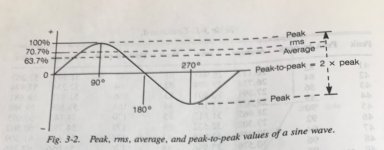The fact is that > RMS voltage , squared , divided by load resistance = WATTS.
( I dare say to invest in a true RMS volt-meter, and double check your PtoP measurements )
( I dare say to invest in a true RMS volt-meter, and double check your PtoP measurements )
Last edited:
Your post 11 is correct but a diode peak detector is not rms conversion so not a very argument.
But don't take my word for it. Look at posts 3, 9, 11, and if you believe them, also post 12. They conform to the Wikipedia page.
But don't take my word for it. Look at posts 3, 9, 11, and if you believe them, also post 12. They conform to the Wikipedia page.
I am just telling you what I know.
The rectification post was obviously "full wave".
There appears to be something you don't understand.
The situation of measuring amplifier output power is something I am very familiar with.
Working for the importing/distributer of BGW amplifiers in Australia >
we had a policy of measuring & testing every amplifier for distribution.
On a near monthly basis I was responsible for testing output power of amplifiers 😎
The rectification post was obviously "full wave".
There appears to be something you don't understand.
The situation of measuring amplifier output power is something I am very familiar with.
Working for the importing/distributer of BGW amplifiers in Australia >
we had a policy of measuring & testing every amplifier for distribution.
On a near monthly basis I was responsible for testing output power of amplifiers 😎
Last edited:
The fact is that > RMS voltage , squared , divided by load resistance = WATTS.
( I dare say to invest in a true RMS volt-meter, and double check your PtoP measurements )
Follow your own advice: get a sine wave on your scope so you can observe peak-to-peak and monitor with an rms voltmeter.
The argument is two to one in voltage, four to one in power. Better make sure you’re correct.
😏
As a quick mental rule of thumb, I divide the p-p by 3 to get ballpark RMS.
40v p-p is 14v = 49w into 4r
50v p-p is 17v = 72w into 4r
60vp-p is 21v = 55w into 8r. (we all know that 20v RMS into 8r is 50watts)
40v p-p is 14v = 49w into 4r
50v p-p is 17v = 72w into 4r
60vp-p is 21v = 55w into 8r. (we all know that 20v RMS into 8r is 50watts)
I am just telling you what I know.
The rectification post was obviously "full wave".
There appears to be something you don't understand.
The situation of measuring amplifier output power is something I am very familiar with.
Working for the importing/distributer of BGW amplifiers in Australia >
we had a policy of measuring & testing every amplifier for distribution.
On a near monthly basis I was responsible for testing output power of amplifiers 😎
And this is how Chinese watts (as they are also called here) are born, and you end up with more audio power in a car than its engine has.
I remember many years ago, at a stall there were tape recorders for sale and on some it was written 1200W PMPO but the consumption was 5-7W from the mains, a real perpetuum mobile, put in 7W and get out 1500W.
In your place, I would be ashamed to say something like that.
The full-wave rectification (fortuitously) achieves the divide by two necessary to calculate power. In terms of heating a resistor, it doesn't matter what the polarity of the voltage across it is (otherwise it would get cold on negative half-cycles!) - this is why the p-p voltage is divided by two.I am just telling you what I know.
The rectification post was obviously "full wave".
There appears to be something you don't understand.
The situation of measuring amplifier output power is something I am very familiar with.
Working for the importing/distributer of BGW amplifiers in Australia >
we had a policy of measuring & testing every amplifier for distribution.
On a near monthly basis I was responsible for testing output power of amplifiers 😎
In simple terms, P=V^2/R, but remember polarity isn't important. That is why it's the peak voltage/sqrt(2), not peak-to-peak.
Did the importer of BGW provide any training?
I think you didn't read this thread before replying - this is wrong and covered in detail above!So, with your 50v peak to peak, convert it to RMS by dividing it by 1.414 = 35.36V RMS.
Then square your 35.36V = 35.36 x 35.36 = 1250.33 . Then divide that by your OHMS > and you get WATTS.
1250.33 divided by 4 (ohms) = 312.5 Watts.
1250.33 divided by 8 (ohms) = 156.3 Watts.
( these power levels are RMS )
YES - I STAND CORRECTEDI'm afraid you forgot to divide the 50V peak-to-peak by 2 to get 25V peak-to-zero.
When you carry this omission through, the 312.5W becomes 78.125W, as andyr calculated.
..................................................
No problem.
I'm 76 and have made more mistakes than I want to think about. Many of those were engineering mistakes, some of them here in this forum.
I'm still breathing, so no doubt I'll make some more.
Truce.
I'm 76 and have made more mistakes than I want to think about. Many of those were engineering mistakes, some of them here in this forum.
I'm still breathing, so no doubt I'll make some more.
Truce.
There's no such term as RMS Power! It came into existence due to very weird reasons and is still being used wrongly to define output power of an amplifierrms power
V rms X I rms = Average Power (Watts)
Last edited:
- Status
- Not open for further replies.
- Home
- Amplifiers
- Solid State
- Testing amplifier output?





